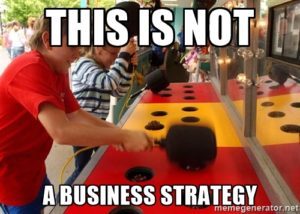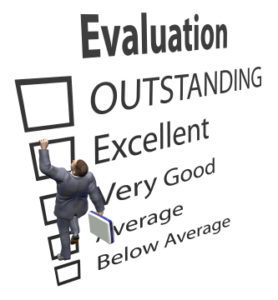Mary E. Marshall's Blog, page 28
October 23, 2016
Plan, Plan and Plan Some More
 As 2016 winds down from fall to winter, it is the time most entrepreneurs and business leaders start thinking about next year. How did we do on the plan this year? What should we focus on next year? Do we have a Strategic Plan?
As 2016 winds down from fall to winter, it is the time most entrepreneurs and business leaders start thinking about next year. How did we do on the plan this year? What should we focus on next year? Do we have a Strategic Plan?
That last question is the one most asked. There are usually goals, and sometimes strategic direction, but for most small companies much more planning than this is rare. The problem, of course, is that if you don’t make it a priority, the direction you are going will be dictated by what is happening today. Or as I like to call it, “the whack-a-mole strategic plan.” We will take care of what comes up because we’re really good at fighting fires and taking care of problems. In other words, we react to circumstances vs. planning for the future.
So rather than just mole slaying, perhaps it’s time to do some quiet reflection and think about why you keep solving the same problem, why you never seem to make progress on your larger strategic goals, and why the team seems to be like arrows moving in different directions.
Strategic planning does not need to be cumbersome, hard or expensive. You need a strategic plan that works for you, not one that takes up space on your bookshelf. This starts with a vision for the future that doesn’t exist today. What could it look like if you had all the resources you don’t have today? Dream big! Dreaming small will just keep you stuck in whack-a-mole mode. Once you have that vision in your head, articulate it. Make it real.
The next step is to identify the “big rocks” or strategic objectives that are needed to get you there, each one having multiple goals and tasks that need to be accomplished. Identify 3-5 Strategic Objectives with 5-10 goals attached to each and that’s all that’s needed to get you started. From there, you rinse and repeat every quarter to make sure you’re on track. If you find you are not on track, the decide what you will do about it. Your Strategic Plan is a living, breathing document, it is not static.
The hard part is defining the vision so that others want to join you on the journey. They will help you get there if it’s inspirational and you have the right team, you will never get there on your own.
Make yourself a promise that this will be the year you “actively” plan the future of your business. Hire a professional to come in and help you with the process. You need to get out of the way and help with the vision, not direct the planning process. Involve your team and create something that will inspire everyone to join in the process – customers included. This year, do something different to get yourself OUT of the whack -a-mole business. Planning is the best defense against a mole infestation.
“When everything seems to be going against you, remember that the airplane takes off against the wind, not with it. “~Henry Ford
The post Plan, Plan and Plan Some More appeared first on Mary Marshall // CEO Coach.
Inspirational Entrepreneurs – The Power of Connecting Peers

2016 SBA Emerging Leaders Program – Graduating Class
The best way to predict the future is to create it. ~
Peter Drucker
The Seattle 2016 SBA Emerging Leaders Class graduated this week with 19 amazing entrepreneurs who created Strategic Growth Plans for each of their businesses that were inspirational and executable. They worked hard over the last 7 months to learn, grow and create something that will take their businesses to the next level. I have had the amazing privilege to be on this journey with them and help guide them to their businesses potential, but rather than me trying to convey the power of this group I thought I would share the words of one of the entrepreneurs – Meg Halverson, CEO of Bright Spring Strategy Consulting – who shared this at our graduation ceremony:
“We have spent 13 sessions over seven months together. On the surface, that seems like a relatively small amount of time. It’s equivalent to a college semester. What we learned, though, and the manner in which we did so, was a bit of a surprise to all of us.
If you had told us in the beginning that an electrician and a landscape architect would have the same issues in bidding work ; that a lab design firm and a management consulting company would face the same challenges in managing contracts; that a tribally owned construction firm and a Montessori school would face the same challenges in hiring and capacity-building, we would have dismissed those ideas as not understanding us or our businesses. We were wrong.
In fact, the most surprising thing we learned – OK, aside from calculating an inventory turn and how much you have to increase sales volume to overcome a price discount, thanks, Mary – was how much we learned from each other. Every class, we learned more about our own businesses, and in the process, about each other’s. We learned about the intricacies of staffing a commercial kitchen and scoping out the best corners of the city for food truck business, of competing with union HVAC shops on bids, about expanding IT services into new geographies and massive, stress-inducing deadlines in the 401K administration business. We learned about each other. We learned what scares us, what excites us and what still, sometimes, dumbfounds us about our own success.
And I’ll say this because it is my biggest takeaway from these productive and enlightening seven months: how important it is to say you don’t know something. Because if you don’t know, you have at least defined what it is you or your staff needs to understand better. If you don’t know why sales are in a landslide, (or taking off like hotcakes), or why you can’t hire a good designer, or why your accountant just won’t give you what you need them to, you need to find out. There’s no one but you to figure it out. The success of our businesses and our future as job creators and entrepreneurs relies on our admitting what we don’t know in addition to our saying with confidence what we do.
What do we know, exactly, after this semester together? We know that hiring is part art and lots of science. We learned that describing your business to investors, clients, and even competitors is a challenge worth meeting in both elevator pitch and business plan form. We learned that Mary expects you to have done your homework. We learned that doing your homework is part of your job as an entrepreneur, and key to your success as a business owner.
We learned a great deal, and we are grateful both for the opportunity to have done so and for the opportunity to celebrate together. Thank you.”
Each and every one of these amazing entrepreneurs is an inspiration to all of us.
“Coming together is a beginning; keeping together is progress; working together is success. “ ~Henry Ford
The post Inspirational Entrepreneurs – The Power of Connecting Peers appeared first on Mary Marshall // CEO Coach.
October 19, 2016
To Review or Not to Review

What’s the purpose of the performance review? The answer largely depends upon your point-of-view. If you’re the manager, it’s what you are told to do by HR. If you’re the employee it’s what you have to endure to get a raise. You will not find a lot of people in large or small companies that like the process. More importantly, there is often not a clear “benefit” to either party from the process.
The origin of performance reviews started in the military when it was necessary to rate and rank those moving up. Companies adopted the process sometime after WWII and ever since we’ve had to “endure” it with little explanation or proof that it actually does any good. What is clear is that it takes an enormous amount of time and the results are usually negligible as far as employee performance enhancement and worst case, productivity goes down.
Maybe it’s time to step back and really reflect on why we are doing it. Each company’s answer may be different. Usually, however, it should be about results. How is the team performing and what can individuals do to help the company or department reach its goals? What can the company do to help the employee reach his/her goals?
If those are the intentions behind doing the process, then what should the process be? Certainly something more than an annual chat. If that’s the only time you give feedback, it’s hard to see how any of it helps improve bad behavior or rewards good behavior. One idea is to separate performance reviews from pay. Decide on your remuneration policies and assuming people are are meeting their goals, they get a raise.
For performance, set goals and objectives at the first of the year. Meet with employees regularly (ideally, monthly) and talk about what’s working, what resources they need and ask how they think they are doing, then mentor and coach them by providing guidance. Remember, this is not all about the company. The employees are people and people have goals as well. Some might be career goals, education goals or monetary goals. As a manager, know what your people want and help them achieve it. If you help them, they help you.
Along the way, you will have to give feedback that is not positive. Studies have shown that this rarely goes well. When doing this, I find that asking the employee how they think they are doing or what they could do better, they will usually nail it. That’s the place to start the conversation. Ask what they think they can do about it and again, they will almost always know. You can provide guidance and encouragement as well to help them be successful. Remember people rarely improve weaknesses, try to enhance their strengths instead. As a manager, it’s your responsibility to make sure people have a chance to be successful. If not, it’s as much on you as it is on the person.
At this time of year when reviews are on your mind, maybe, just maybe, it’s a good time to step back and re-evaluate the purpose behind doing them. You might be able to improve the process for your company, yourself and your employees.
The post To Review or Not to Review appeared first on Mary Marshall // CEO Coach.
October 11, 2016
The Art of Listening
 “It takes two to speak the truth – one to speak and another to hear.” ― Henry David Thoreau
“It takes two to speak the truth – one to speak and another to hear.” ― Henry David Thoreau
Good leaders listen. Great leaders listen well. Listening is not waiting to talk, or waiting for your moment to jump in and relate your story or solve the problem. We all do that, it’s natural. Our brains are hardwired to listen for similarities and very quickly review everything in our memory banks that relates to our story or helps solve an issue. Essentially giving us information so we can talk. More rarely, do we actually listen to what’s being said without anticipating our own response.
If you think about anyone you’ve considered a great leader or mentor in your life, think about how they listened to you. Did you feel as if they “really understood” you? Much like love, this is a feeling we humans crave. We seek it out. We keep trying to get our story out, and our opinion across so someone hears us. Being truly listened to is as close to being loved as some people ever get. We have a physiological need to be heard. “Being heard is so close to being loved that for the average person, they are almost indistinguishable.”― David Augsburger
In this era of overcommunication, conflicting data from everywhere, talking heads on every social media channel, who is actually listening to what is being said? When we are not heard, we get upset, we get angry, we protest, we act out – all trying to be heard.
Dialogue, implies “two,” from the Latin root “di.” This means one speaker and one listener, not two talkers. If all we do is talk and no one listens, how will anything ever be changed? Be moved or accomplished? It’s not possible because we need each other and we need to collaborate effectively in order to move the needle.
Great leaders know that listening is a strength, a skill that will serve them, the organization, and the cause well. In order for anyone to listen to you, you must first listen to them. Talking over someone is not listening, it’s just the opposite. Invalidating all that is trying to be said. Listening is not a sound bite. It is a true desire to understand what the person is saying, how they feel and what they are asking for – which is often, just to be heard and understood. This doesn’t mean agreement with whatever is being said. It means actively listening to understand the point-of-view and the communication of another. Not to solve, disagree or help, just to understand and hear.
Great leaders are great listeners. They know and understand what is being said. They know how to empathize and to make someone feel heard. Listening is a long lost art that we all need to start practicing – it’s more powerful than speaking.
So in this era of hyper “talking,” let’s all stop waiting to talk and listen to what’s being said. We might be surprised at what we hear.
The post The Art of Listening appeared first on Mary Marshall // CEO Coach.
October 5, 2016
Everyday Leadership
 I heard a TED Talk last week and I was reminded why leadership is really a series of everyday moments. Drew Dudley told a story about how one thing he did several years ago ended up being a turning point in someone else’s life. The funny thing was, he didn’t even remember doing it. I think this is probably true for most of us.
I heard a TED Talk last week and I was reminded why leadership is really a series of everyday moments. Drew Dudley told a story about how one thing he did several years ago ended up being a turning point in someone else’s life. The funny thing was, he didn’t even remember doing it. I think this is probably true for most of us.
We are all leaders in our lives, our families, our communities, our work and just about every opportunity we have to touch other human beings. Leadership is not about a title, it’s about what you do as a human to help or inspire others. Dudley talks about it as times when “you fundamentally make someone’s life better.” If we take that as the most basic definition of leadership, we can all do that, every day.
One of the reasons I work with entrepreneurs is that they make such a difference in people’s lives, and rarely do they have any idea of the ripple effect of what they do. Things like giving a high school kid a chance to learn new skills and get started in the professional world, even though they are completely clueless about most everything when it comes to “work.”
One of my entrepreneurs from last year’s Emerging Leaders class had hundreds of responses on Facebook when she asked for past employees to help her with stories about how their first job had impacted their lives. The outpouring was amazing and touching and she had not remembered most of the circumstances of the stories.
There are so many facets and connotations of “leadership,” most of which start with leading something big or grand, or having a position of authority, or somehow being in charge. When in reality, those are only some of the ways you can lead. Leadership is not about making anyone do anything. It’s about inspiring those to do for themselves or to join with others to do something together. Good leadership is fundamentally about making someone’s life better.
So how about for the month of October we pay attention to those around us and just ask how we can make things a bit better? A coworker having a bad day, a parent at the grocery store with a screaming child, an elderly shut-in who might need a visit, a team who needs a helping hand. Good deeds are never forgotten. And that’s leadership.
“Believe you can and you’re halfway there.” ~ Theodore Roosevelt
The post Everyday Leadership appeared first on Mary Marshall // CEO Coach.
September 29, 2016
Holding Leadership Accountable
 The leadership face plant at Wells Fargo I wrote about last week is not going to be corrected by a few cosmetic fixes.
The leadership face plant at Wells Fargo I wrote about last week is not going to be corrected by a few cosmetic fixes.
This week, it was announced that the Manager in charge of the team will be “resigned” immediately instead of at the end of the year and have some compensation taken back. The CEO, Stumpf, will have $41M clawed back from his compensation. This was a result of the Board finally doing what a Board is supposed to have been doing all along:
Assess the risks inherent in the company’s business and handle them before they develop into a crisis.
Dispense compensation that does not encourage bad behavior.
Monitor a company’s culture, from top to bottom.
In reality, leadership had been monitoring the culture – one of corruption and fraud – and handsomely profiting from it. The failure came from the first two points, not really assessing the risk of such corrupt sales practices and clearly dispensing compensation that encouraged the bad behavior.
CEOs are the guardians of company culture. It is incumbent upon them to make corrections to processes and people when things are off track. But as I said last week, results were more important than anything else at Wells Fargo, so how they were being achieved was not important. Stumpf was absolutely guarding his “results” and that of the company so that everyone benefited except, of course, customers and the employees who were asked to carry out the illegal behaviors. As Elizabeth Warren said of Stumpf’s pathetic performance on Capitol Hill, it was “gutless leadership.” But he did do one thing “well,” he monitored and preserved the company’s culture as long as results were produced, too bad that in his world corruption and fraud were acceptable cultural components.
At the end of the day, the salary forfeited by the CEO and the manager are minimal. They will still be multi-millionaires many times over and not prosecuted for their illegal behavior. (Wouldn’t you love to see them on the side of the road in orange jumpsuits picking up our trash?) Meanwhile, the employees who were fired for doing what they were told to do, have a black mark on their employment history and likely suffered much worse.
The final coup de grace in all of this are the revelations about the “ethics hotline” Wells Fargo had set up. Employees all went through ethics training and were told to call the hotline if they ever saw unethical behavior – and the reward for those whistleblowers who did? They were fired. Fortunately, they are now banding together in a class-action lawsuit against Wells Fargo due to the retaliation they experienced.
The only steps that might cause real change are a complete turnover of leadership and a cultural retrofit from top to bottom. What needs to be put in place is an ethical and moral way to provide products and services, create and maintain jobs and a legal way to earn profits. The critical first step that will show Wells Fargo intends to mend its ways is to fire the CEO – he has NO credibility or ability to change or “reform” himself or the organization. Next, they need to start with values, at a fundamental level. What should they be? Then align all people and processes behind those and the resulting objectives and you might remake it into a different company. Leadership matters. Good, values-based leadership produces extraordinary results. Winning doesn’t require cheating – it does require being good or even the best, solid values, and a leader who leader who is the guardian.
How can we as customers and the general public help make these types of changes at organizations where fraud and corruption are the norms? Don’t buy from them and don’t work for them. Banks have long used our money for their gains – it’s their product. Take your money back, use local or regional banks that don’t have deceptive and illegal practices or create an alternative to banks. Time for entrepreneurs to take advantage of their innate ingenuity and innovation to replace the “banking system” entirely. And remember, “Nothing strengthens authority as much as silence.”— Leonardo da Vinci
By The original uploader was Henry W. Schmitt at English Wikipedia (Transferred from en.wikipedia to Commons.) [Public domain], via Wikimedia Commons
The post Holding Leadership Accountable appeared first on Mary Marshall // CEO Coach.
September 20, 2016
Do The Right Thing
Do the right thing. It will gratify some people and astonish the rest. ~Mark Twain
 In another example of an organizational culture gone awry – this time with devastating consequences for one young man and his family – the Marine Corps’s Third Recruit Training Battalion talks about its “Culture of Toughness.”
In another example of an organizational culture gone awry – this time with devastating consequences for one young man and his family – the Marine Corps’s Third Recruit Training Battalion talks about its “Culture of Toughness.”
In this case, there is the line between abuse and teaching recruits to be tough. Based on this article, it’s clear this division had a reputation for crossing that line. The leadership encouraged and allowed extremely abusive behavior and unfortunately, it took a death for the culture to be scrutinized.
We’ve all been involved in situations that are awful because a leader or someone in power is behaving inappropriately. Often times we do nothing because we are not in charge and fear the repercussions. This is how negative or non-productive cultures take over – by people doing nothing. It’s also how bullies get away with bullying behaviors.
The problem with doing nothing is that we go against our own values. At the end of the day, the only person that can stop you from doing the right thing is you. The situation may not turn out as you hope, but you will have acted with integrity and alignment with your values. In an organization where the culture has veered from its stated values, the only way to get it back on track is by those “in it” to reclaim the values by doing the right thing. There is no honor in condoning abuse, hatred, bigotry or any other horrific form of behavior. Silence is agreement which only emboldens the leader and they become worse.
Yes, standing up for what you believe is right may make you unpopular and have negative consequences, but do you want to be in an organization whose values you oppose? Only when the majority say no, will things change.
As a leader, it’s up to you to set the example. Ask yourself if you are behaving in a way consistent with the values of the organization. Are you living the values and setting good examples for your team? Are you measuring and monitoring the behavior and results of others so the entire organization is aligned with the values? Are all your processes and procedures consistent with your values?
Changing culture is hard, often you have to start at the beginning and create a new foundation with the basics of values, understanding, training and a reset of everything in the organization, (which can potentially include removing some of your people). Maintaining a good, productive culture is much easier. It’s about knowing when to pull up the weeds of unintentional culture as soon as you spot them and rewarding “alignment” of the values.
At the end of the day, it’s about doing the right thing and that’s on all of us, not just the leader. Because we are all leaders in our own lives and we will end up becoming what we tolerate. So know who you are, know what you value and doing the right thing becomes much easier.
photo credit: thumbs up via photopin (license)
The post Do The Right Thing appeared first on Mary Marshall // CEO Coach.
Leadership: When Results Matter More Than Ethics
 The recent Wells Fargo scandal is outrageous not only due to the scale of the fraud, but also the absolute lack of accountability by the leadership. Let’s just be clear, signing up millions of unsuspecting customers for new accounts to achieve sales goals is not a good business strategy for any company, on any day, on any planet.
The recent Wells Fargo scandal is outrageous not only due to the scale of the fraud, but also the absolute lack of accountability by the leadership. Let’s just be clear, signing up millions of unsuspecting customers for new accounts to achieve sales goals is not a good business strategy for any company, on any day, on any planet.
In a well-considered Op-Ed piece in the New York Times the author rightly points out that the head of the division responsible for the fraud is not even remotely being held accountable. In fact, she is being “retired” with a golden parachute worth up to $125M, accompanied by her salary of $27M over the last three years. It sounds to me like she was rewarded for her “wonderful performance.”
Couple this with the fact the CEO, John G. Stumpf, said all of this was the result of bad employees plotting against the customers and the company – making him a “victim” as well – and we have one of the most spectacular displays of bad leadership in recent memory. Unfortunately, it’s not as surprising as it should be. This fraud didn’t happen overnight, in a vacuum. It is the result of the organization’s culture, led by Stumpf.
Good bad or indifferent, if you are the leader, “it’s on you.” Culture is the manifestation of the values you emphasize in the workplace, your style, and what you expect and inspect. Blaming employees that, oh, by the way, work for him, and then rewarding the manager in charge of the fraudulent team, tells us EVERYTHING we need to know about Stumpf’s values. Unfortunately, it’s a striking display of Intentional Culture. I would say it’s a result of “Unintentional Culture” if it were a few rogue players and when the scandal came to light, it was handled differently, but in fact, the leaders’ behaviors were in complete alignment with a culture that encouraged and rewarded this type of behavior. 5,300 employees doing something is not a “rogue” event, it’s a movement, that created results the leadership wanted and rewarded.
Culture is not only what people say, it’s what they do. Values drive beliefs, beliefs drive actions and actions become your reputation. For Wells Fargo, this reputation will affect its bottom line for a long time to come.
There is always a “culture” in any organization. As the leader, it’s on you to make sure it’s the one you want. Even if we give Stumpf the benefit of the doubt that he didn’t know exactly what was going on, he had to have seen the results. He saw the $200 million his personal stock appreciated over that time. But with those amazing results, there had to have been customer complaints. Two million fraudulent new accounts don’t get created without some level of customers questioning what was happening. Yet, nothing was done. As Theodore Roosevelt said, “In any moment of decision, the best thing you can do is the right thing, the next best thing is the wrong thing, and the worst thing you can do is nothing.” When it comes to doing the right thing, doing nothing is not an option.
The post Leadership: When Results Matter More Than Ethics appeared first on Mary Marshall // CEO Coach.
September 14, 2016
Love in the Workplace – Really?

I know you’re rolling your eyes right about now after reading the title, but hear me out for a moment, (or at least for 500 words!). There was a great piece in the Harvard Business Review recently regarding “love” in the workplace and how you can and should think about harnessing it because the reality is that it’s already there. This is not about finding a partner or a mate at work, it’s about something that is inherently part of the culture.
I’ve talked a lot about intentional culture, and the opposite, unintentional culture. What the author of the HBR article says is that love, which could be defined as caring, respect, compassion, and kindness, is always present, but often not stated or recognized. This is unintentional culture. You’re not going to get rid of it, humans need and want it in their personal lives, so why would they not seek it out at work as well?
His point is that you can actually harness this for the good of the organization. So rather than ignoring it and pretending it’s the purple elephant in the room that no one sees, embrace it and you might be surprised at the results.
As always, I go back to values. One of my personal values is caring – caring for others and for myself. The author would say this is “love.” So why don’t I just call it that? Because it makes me uncomfortable to declare “love” and “caring” sounds more acceptable, (but it’s really the same thing).
One CEO I worked with defined the values in her company and one of them was indeed “love.” They said, “love, yes, love.” Just in case someone didn’t get the message. And far from this simply being a value on the wall, unlived in the organization, it was present in all they did. As a marketing firm, they needed to really understand their clients, their staff and the projects. They put “love” into their work, they treated others with kindness and respect and were very tolerant with employees, as long as “love” was respected and the work got done well. This was living the value of love.
Love is not “soft” and “squishy” as a value word in an organization. In fact, it takes courage to declare it and have everyone quietly think you’ve gone a bit soft or strange. It’s about declaring it as a value and talking about how it can move the organization forward, what it means to you as the leader and consequently, what it means to your employees. Often times, being appreciated is as close as some employees get to feeling loved. And what happens when we feel loved? We are happier and are more productive. It’s not a soft or squishy values word, it produces results.
You won’t see this in large organizations because typically their focus is on shareholder value and love would be abandoned as “weird” or “unnecessary” or just plain crazy. In smaller organizations, however, it matters. It may not be stated, but it’s present. And what are millennials looking for in a workplace? Someplace where the work matters and where they matter – isn’t that love?
photo credit: Summer Love via photopin (license)
The post Love in the Workplace – Really? appeared first on Mary Marshall // CEO Coach.
September 7, 2016
What Would Your Employees Say?
 As the employment market tightens in most major cities and the battle for top talent heats up, it might be a good time to figure out what your employees are saying about your company. As an employer, it would be good for you to know if they are looking or being tempted by other offers as well as whether they would recommend your organization as a good place to work.
As the employment market tightens in most major cities and the battle for top talent heats up, it might be a good time to figure out what your employees are saying about your company. As an employer, it would be good for you to know if they are looking or being tempted by other offers as well as whether they would recommend your organization as a good place to work.
Remember, it’s not all about pay, although that is important. It’s about a good workplace, somewhere they actually look forward to spending 40+ hours per week at, not just tolerating. It’s about opportunities to learn and grow, advancement potential and generally feeling like what they do matters. The easiest way to take the temperature is this set of questions originally developed by the Gallup organization years ago.
Do I know what is expected of me at work?
Do I have the equipment and materials I need to do my work right?
At work, do I have the opportunity to do what I do best every day?
In the last 7 days, have I received praise or recognition for good work?
Does my supervisor, or someone at work, seem to care about me as a person?
Is there someone at work who encourages my development?
At work, do my opinions seem to count?
Does the mission or purpose of my company make me feel like my work is important?
Are my coworkers committed to doing quality work?
Do I have a best friend at work?
In the last 6 months have I talked with someone about my progress?
This past year have I had opportunities to learn and grow?
If your employees can answer “Yes” to most or all of these, you probably have a very productive workforce. However, if it’s more like half yes and no, you run the risk of losing good employees and might have trouble recruiting. It takes employees less than 5 minutes to fill this out. Make sure to do it anonymously or you won’t get accurate answers. Plug the questions into one of the online survey tools like SurveyMonkey if you want to make it even easier.
The key is to have the intention of actively dealing with whatever themes or concerns show up. Not all of them, but select one or two as priorities. Remember communication is a key to good leadership so state a purpose for doing the survey – “we want to make sure you are all getting what you need” – or something similar before sending it out. Let them know that depending upon the responses, each issue or concern will be dealt with according to the priority and breadth of the responses. Don’t make it mandatory. If people don’t want to participate, that will tell you something. Once you have the responses, pick the one or two things that are most concerning and address them in some way. Communicate what was selected and that you will be doing the survey in another 6-12 months to see how it’s going. If you don’t plan to address any of the issues that come up in the survey, don’t do it in the first place. You will only make things worse and reinforce the perception that you don’t care as an employer.
Just the fact that you are concerned about your employees – how they feel and that you want them to be able to answer yes to these types of questions – will go a long way towards improving workplace morale. It is also likely to enhance productivity and stave off some people from leaving for what might be considered greener pastures. And when recruiting, you can mention that you conduct a survey on a regular basis and take action based on the findings. This matters to new recruits
The post What Would Your Employees Say? appeared first on Mary Marshall // CEO Coach.



